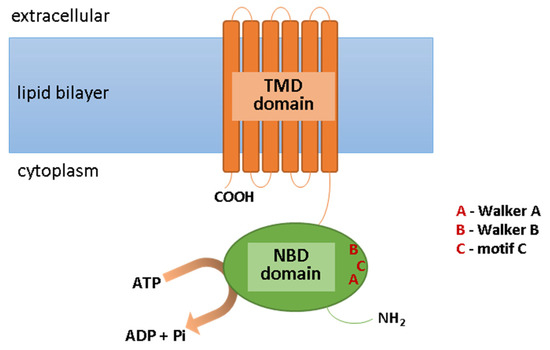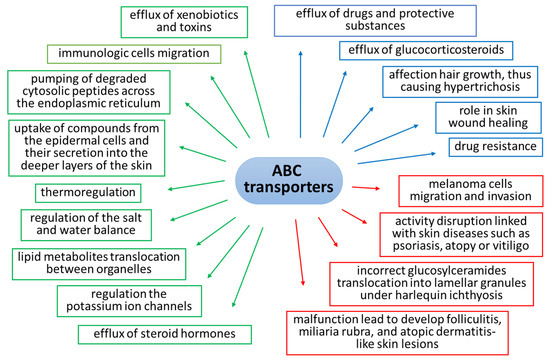Your browser does not fully support modern features. Please upgrade for a smoother experience.
Please note this is an old version of this entry, which may differ significantly from the current revision.
Subjects:
Biochemistry & Molecular Biology
ABC transporters are expressed in skin cells to protect them against harmful xenobiotics. These transmembrane proteins have a number of additional functions that ensure skin homeostasis.
- ABC transporters
- skin
1. ABC Transporters
ABC transporters are expressed in many epithelial and endothelial barrier tissues/cells, limiting the penetration of the xenobiotics between the body’s compartments. They are located, among other places, in the cells of the liver, kidneys, the epithelium of the small intestine, the blood–brain barrier, and the blood–retina barrier; they are present, however, not only in the plasma membrane, but also in intracellular membranes surrounding cell organelles, e.g., peroxisomes, lysosomes, mitochondria, and the endoplasmic reticulum [9,10,11]. They are involved in the elimination of metabolic byproducts from cells and protection against xenobiotics, including toxins, carcinogens, cytotoxic components of the diet, and drugs. ABC transporters fulfill their functions through the ejection of molecules from the cell. Usually, this process requires energy; therefore, ABC transporters have the ability to bind the ATP and to hydrolyze it to ADP and phosphate (Pi) with energy generation [12]. This is necessary for the translocation of molecules across the cell membrane, contrary to its concentration gradient, this being possible due to the specific structure of ABC transporters. These transmembrane proteins are fairly conserved in composition. Their structure includes the ATP-binding domain (NBD), which exhibits ATPase activity and is responsible for ATP hydrolysis. As a result of this reaction, the second important component of ABC transporter, i.e., the transmembrane domain (TMD), can change in conformation [13]. This is important due to the fact that TMD is the domain that recognizes substrates and marks the paths of their translocation across the cell membrane. Moreover, the motifs Walker A and Walker B are present within the NBD domain, which are characteristic of all ATP-binding proteins, as well as motif C (ABC Signature Motif), with the sequence “LSGGQ,” which is only specific for ABC proteins (Figure 1). In the construction of ABC transporters, other regions can be distinguished such as loops A, Q, D, H, and X, which affect the classification of these proteins’ subfamilies [14]. However, due to the amino acid sequence in the NBD region and its structural organization, all ABC transporters have been grouped into seven subfamilies, from ABCA to ABCG (Table 1). In addition to the systematic name, some of these transporters are known by different names, including MDR1/3 (multi-drug resistance transporter; ABCB1/4), TAP1/2 (transporter associated with antigen processing; ABCB2/3), MRP1-6 (multidrug resistance-associated protein; ABCC1-6), MRP7-9 (ABCC10-12), CFTR (cystic fibrosis transmembrane conductance regulator; ABCC7), SUR1/2 (sulfonylurea receptor; ABCC8/9), and BCRP (breast cancer resistance protein; ABCG2) [15,16].

Figure 1. Scheme of the ABC transporter structure. Abbreviations: ADP, adenosine diphosphate; ATP, adenosine triphosphate; NBD, ATP-binding domain; Pi, phosphate; TMD, transmembrane domain.
Table 1. The list of ABC transporters with their main functions. Abbreviations: ABC, ATP-binding cassette transporter; BCRP, breast cancer resistance protein; CFTR, cystic fibrosis transmembrane conductance regulator; MDR, multi-drug resistance transporter; MRP, multidrug resistance-associated protein; SUR, sulfonylurea receptor; TAP, transporter associated with antigen processing.
| Subfamily | Transporters | Main Function |
|---|---|---|
| ABCA | ABCA 1-9, 12 | transport of cholesterol and lipids |
| ABCB | ABCB 1 (MDR1), ABCB 2-3 (TAP1-2), ABCB 4 (MDR3), ABCB 5-11 |
transport of peptides and metabolites |
| ABCC | ABCC 1-6 (MRP1-6), ABCC 7 (CFTR), ABCC 8-9 (SUR1-2), ABCC 10-12 (MRP7-9) |
transport of ions, cell-surface receptors |
| ABCD | ABCD 1-4 | participate in peroxisome activation |
| ABCE | ABCE 1 | multidrug resistance |
| ABCF | ABCF 1-3 | regulation of innate immune response |
| ABCG | ABCG 1, ABCG 2 (BCRP), ABCG 4,5,8 |
transport of drugs, toxins, lipids, cholesterol and other steroids |
2. ABC Transporters in the Skin
The expression and activity of ABC transporters in skin cells is indisputably linked to their role in skin protection against harmful xenobiotics and the oxidative stress that they induce [6]. However, the current knowledge concerning these proteins allows for the conclusion that the activity of ABC transporters is dependent on numerous factors and that they have a much wider range of action in relation to skin cells (Figure 2).

Figure 2. Roles and functions of ABC transporters in skin cells under physiological conditions (green), in pathological states (red), and during therapy (blue). Abbreviation: ABC, ATP-binding cassette transporter.
2.1. Activation and Suppression According to Oxidative Conditions
It is generally assumed that the appearance of an agonistic xenobiotic in the cytoplasm of the cell activates the ABC transporters and induces the efflux of this potentially harmful compound outside the cell [6]. Exposure to these compounds is very often accompanied by oxidative stress (the oxidative effect of these compounds or a side effect of their metabolism). It has not been shown that free radicals formed at the time of exposure directly affect the functioning of ABC transporters; however, there are many pathways linking oxidative stress with these transporters [17,18]. Reactive oxygen species (ROS) conjugated with GSH, glucuronide, and sulphate only are agonistic molecules for ABC transporters [19]. However, in the case of lung cancer cells, it was found that low doses of anticancer drugs, by inducing a moderate increase in ROS levels (approximately a 3-4-fold increase of the control levels), promote a defense response which results in an increase in the expression of ABC proteins, thus providing these cells with drug resistance [18]. This might be connected with an ROS-induced activity of transcription factors, such as nuclear factor-κB (NFκB), responsible for the formation of inflammation, and nuclear factor E2-related factor-2 (Nrf2), responsible for the biosynthesis of antioxidant proteins [20]. Therefore, NFκB increases the expression of ABC transporters during inflammation [21,22], while Nrf2 initiates ABC transporters in response to oxidative stress [23,24].
Oxidative stress arising from, e.g., exposure of cells/organism to pathogenic factors (exogenous and endogenous), often leads to the activation of kinases involved in intracellular signal transduction, including mitogen-activated protein kinases (MAPKs) [25]. As a result, numerous proteins are phosphorylated, including ABC transporters. The data in the literature indicate that the phosphorylation of ABC proteins is often a constitutive element of the functioning of transporters, and is necessary for their full activity, especially under oxidative conditions [26]. Moreover, MAPKs activation by ROS additionally induces NFκB and Nrf2 activity, thus favoring the expression of ABC transporters [24,27].
It is known that, while oxidative stress activates most ABC transporters, antioxidants such as vitamin C, flavonoids, or phytocannabinoids are able to suppress their activity [28,29,30,31]. Due to the recent increased public interest in aging and disease prevention, the use of herbal preparations, especially those containing high doses of natural antioxidants, has become very popular, raising the potential for interactions with the implemented drug therapies. In relation to the influence of antioxidants on ABC transporters, their action is not only based on ROS scavenging, but they are also able to inhibit drug interaction with ABC transporters during therapy, as well as prevent nucleotide hydrolysis, thus limiting the access of transporters to the energy from ATP hydrolysis [30]. Therefore, antioxidants could be considered as potential modulators of multidrug resistance and as therapeutic agents to suppress ABC transporter activity under drug-induced oxidative conditions.
2.2. Main Functions in the Skin
It has been reported that ABC transporters in the skin have different intensities of distribution in the epidermis compared to the dermis. For example, MRP1 has a strong expression in whole skin specimens and the dermis, and a weak expression in the epidermis [32]. This leads to the uptake of compounds from the epidermal compartment and their secretion into the deeper layers of the skin. Moreover, by coordinating the efflux of steroid hormones from normal human epidermal keratinocytes, ABC transporters ensure proper hormonal balance in the skin [33]. ABC transporters’ expression in human skin biopsies has been correlated with sweat metabolites, which indicates their role in sweat secretion and, thus, an indirect effect on body thermoregulation [34]. By removing contact allergens and exogenous compounds, such as fragments of pathogens, outside the cell, ABC transporters also play an important role in the migration of Langerhans cells and help maintain a healthy immune response in the skin [35,36]. ABC transporters also translocate lipid metabolites between cell organelles in order to regulate lipid homeostasis and prevent disease development [37]. It has been found that a dysfunction of ABCA12, which is responsible for the translocation of glucosylceramides (GlcCer) into lamellar granules, leads to a disturbance of the skin’s barrier functions and is even co-responsible for the development of a rare skin disease called harlequin ichthyosis [38].
ABC transporters also have play a significant role in melanoma, as well non-melanoma skin cancers, where the expression of these molecules is always present in a high level compared to non-cancerous human skin cells [39,40,41,42]. The exact mechanism of the ABC proteins expression in skin cancer cells is not known; however, ABC-dependent drug efflux in these cells leads to cancer multidrug resistance by decreasing intracellular drug accumulation [41,43,44,45]. Moreover, ABC transporters additionally protect the mitochondrial genome of melanoma cells against drug-induced DNA damage [43]. It has also been observed that high levels of ABC transporters in melanoma cells favors their migration and invasion, being a prognosis of numerous metastases and failure of anticancer therapy [8,46].
The presented examples are only a fragment of ABC transporters’ role in the skin that is currently known. However, it can already be seen at this stage how important they are in the functioning of cells both in normal physiology and in pathological states (Figure 2).
This entry is adapted from the peer-reviewed paper 10.3390/ijms24010115
This entry is offline, you can click here to edit this entry!
